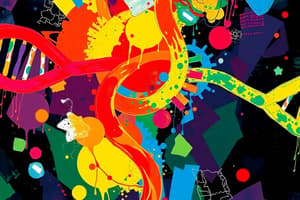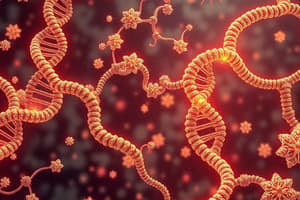Podcast
Questions and Answers
Which of the following is NOT a characteristic of DNA, according to the information?
Which of the following is NOT a characteristic of DNA, according to the information?
- It is bidirectional.
- Contains deoxyribose sugar.
- Contains ribose sugar. (correct)
- It is known as ADN.
What are the two classifications of nitrogenous bases?
What are the two classifications of nitrogenous bases?
- Adenine and Guanine
- Thymine and Cytosine
- Uracil and Adenine
- Purines and Pyrimidines (correct)
According to Chargaff's rule, which base pairing is correct in RNA?
According to Chargaff's rule, which base pairing is correct in RNA?
- A = ARNU
- G = T
- A = T
- G = C (correct)
Which of the following is NOT a function of RNA?
Which of the following is NOT a function of RNA?
Which of the following is NOT a component of a nucleotide?
Which of the following is NOT a component of a nucleotide?
Which of the following characterizes inorganic biomolecules?
Which of the following characterizes inorganic biomolecules?
Which sugar is present in RNA?
Which sugar is present in RNA?
Which of the following nitrogenous bases is NOT found in DNA?
Which of the following nitrogenous bases is NOT found in DNA?
Which of the following are organic biomolecules?
Which of the following are organic biomolecules?
Who contributed to the understanding of the structure of DNA?
Who contributed to the understanding of the structure of DNA?
What is DNA also known as?
What is DNA also known as?
Which purines are present?
Which purines are present?
What is a nucleoside composed of?
What is a nucleoside composed of?
What is the sugar present in ARN?
What is the sugar present in ARN?
Which of the following is the function exclusive to RNA among the options provided?
Which of the following is the function exclusive to RNA among the options provided?
What is the key difference in sugar composition between DNA and RNA?
What is the key difference in sugar composition between DNA and RNA?
Explain the difference between nucleoside and nucleotide.
Explain the difference between nucleoside and nucleotide.
If a strand of RNA contains 30% adenine, what percentage of uracil will it have, assuming Chargaff’s rules are applicable?
If a strand of RNA contains 30% adenine, what percentage of uracil will it have, assuming Chargaff’s rules are applicable?
How does the bidirectional nature of DNA replication contribute to genetic stability and diversity?
How does the bidirectional nature of DNA replication contribute to genetic stability and diversity?
Which of the following best illustrates the relationship between the contributions of Rosalind Franklin and those of Watson and Crick in determining the structure of DNA?
Which of the following best illustrates the relationship between the contributions of Rosalind Franklin and those of Watson and Crick in determining the structure of DNA?
Which is/are considered inorganic biomolecule/s?
Which is/are considered inorganic biomolecule/s?
What type of sugar does DNA contain?
What type of sugar does DNA contain?
What is the name of sugar present in RNA?
What is the name of sugar present in RNA?
Which of the options mentioned here is/are organic biomolecules?
Which of the options mentioned here is/are organic biomolecules?
Which one of these molecules below is a pyrimidine?
Which one of these molecules below is a pyrimidine?
Which statement accurately describes the structure of RNA as opposed to DNA?
Which statement accurately describes the structure of RNA as opposed to DNA?
According to the information provided, which is the correct pairing in DNA?
According to the information provided, which is the correct pairing in DNA?
What kind of helix form does DNA take, as mentioned?
What kind of helix form does DNA take, as mentioned?
Which definition best describes the function of mRNA?
Which definition best describes the function of mRNA?
A newly discovered biomolecule contains ribose, a phosphate group, and uracil. Which type of molecule is it most likely to be?
A newly discovered biomolecule contains ribose, a phosphate group, and uracil. Which type of molecule is it most likely to be?
In what way might the lack of thymine in an RNA molecule specifically affect its stability or function?
In what way might the lack of thymine in an RNA molecule specifically affect its stability or function?
Within a eukaryotic cell, where would you primarily find nucleic acids carrying out distinct genetic instructions?
Within a eukaryotic cell, where would you primarily find nucleic acids carrying out distinct genetic instructions?
Which is the correct expression for Chargaff's rule?
Which is the correct expression for Chargaff's rule?
Which molecules are classified as purines?
Which molecules are classified as purines?
Which molecule can be classified as a pyrimidine?
Which molecule can be classified as a pyrimidine?
What is the main characteristic of biomolecules?
What is the main characteristic of biomolecules?
Compare and contrast the structural components and functions of DNA and RNA within a cell; elaborate mechanisms either nucleic acid uses to maintain genetic info or translate it into protein synthesis.
Compare and contrast the structural components and functions of DNA and RNA within a cell; elaborate mechanisms either nucleic acid uses to maintain genetic info or translate it into protein synthesis.
Flashcards
Biomolecules
Biomolecules
Molecules present in living organisms.
Organic Biomolecules
Organic Biomolecules
Biomolecules that contain carbon.
Inorganic Biomolecules
Inorganic Biomolecules
Biomolecules that do not contain carbon.
Nucleic Acids
Nucleic Acids
Signup and view all the flashcards
Deoxyribonucleic Acid (DNA)
Deoxyribonucleic Acid (DNA)
Signup and view all the flashcards
Ribonucleic Acid (RNA)
Ribonucleic Acid (RNA)
Signup and view all the flashcards
Deoxyribose Sugar
Deoxyribose Sugar
Signup and view all the flashcards
Ribose Sugar
Ribose Sugar
Signup and view all the flashcards
DNA Nitrogenous Bases
DNA Nitrogenous Bases
Signup and view all the flashcards
RNA Nitrogenous Bases
RNA Nitrogenous Bases
Signup and view all the flashcards
Nucleotide components
Nucleotide components
Signup and view all the flashcards
Purines
Purines
Signup and view all the flashcards
Pyrimidines
Pyrimidines
Signup and view all the flashcards
Nucleotide Composition
Nucleotide Composition
Signup and view all the flashcards
mRNA
mRNA
Signup and view all the flashcards
rRNA
rRNA
Signup and view all the flashcards
tRNA
tRNA
Signup and view all the flashcards
Study Notes
- The notes discuss biomolecules, which are divided into organic and inorganic types.
Organic Biomolecules
- Include lipids, proteins, carbohydrates, nucleic acids, and vitamins.
Inorganic Biomolecules
- Include water (H2O) and mineral salts.
Nucleic Acids
- There are two types: deoxyribonucleic acid (DNA) and ribonucleic acid (RNA).
- Rosalind Franklin contributed to the discovery of DNA.
- Watson & Crick further developed the DNA model.
- DNA is dextrorotatory and Bidirectional.
- DNA contains deoxyribose sugar.
- RNA contains ribose sugar.
- There are three types of RNA: messenger RNA, ribosomal RNA, and transfer RNA.
Nucleotides Composition
- Consist of sugar, phosphoric acid, and a nitrogenous base.
Nitrogenous Bases in DNA
- Adenine (A)
- Cytosine (C)
- Thymine (T)
- Guanine (G)
Nitrogenous Bases in RNA
- Adenine (A)
- Guanine (G)
- Cytosine (C)
- Uracil (U)
Chargaff's Rule
- A = T in DNA or A in RNA
- G = C
- Nucleosides are formed by a pentose sugar and a nitrogenous base.
Nitrogenous Bases Classification
Purines
- Adenine
- Guanine
Pyrimidines
- Thymine
- Cytosine
- Uracil
Studying That Suits You
Use AI to generate personalized quizzes and flashcards to suit your learning preferences.




